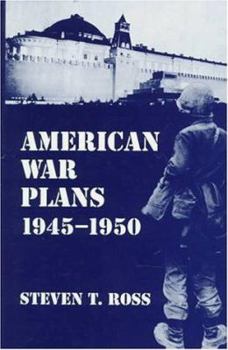American War Plans, 1945-1950
Select Format
Select Condition 
Book Overview
In late 1945, it became clear that the Soviet Union was an aggressive power. American military planners began to develop strategies to deal with the frightening possibility of a war with the Soviet... This description may be from another edition of this product.
Format:Paperback
Language:English
ISBN:0714641928
ISBN13:9780714641928
Release Date:April 1996
Publisher:Routledge
Length:204 Pages
Weight:0.60 lbs.
Dimensions:0.6" x 5.6" x 8.5"
Customer Reviews
1 rating
A nice overview
Published by Thriftbooks.com User , 23 years ago
"American War Plans: 1945-1950" by Steven T. Ross is a detailed look at the planning that the United States undertook in the period from the end of World War II to the beginning of the Korean War in order to meet the rising Soviet threat, with a strong emphasis on the word "plan". If you are looking for a book on early Cold War politics, or even a look at U.S. grand strategy in the post-war era, this is not what you are looking for. Ross concerns himself exclusively with the military's contingency planning for open war with the U.S.S.R., and given the hypothetical nature of that planning, and the vastly reduced role in policy formulation the military enjoyed post 1945, these plans are exercises in threat evaluation, and generally speaking, not power politics.Ross' work opens with perhaps one of the great ironies of the Cold War: by 1946 the U.S. military, arguably the most powerful armed force in history at the end of WWII, and certainly the most well rounded, had been gutted to the point that it was not only incapable of defending Western Europe, it was largely incapable of even slowing the U.S.S.R. down. At the same time, there is the puzzling dichotomy of a military forced to rely on atomic weapons to compensate for a lack of conventional forces, at the same time that they have no idea how many weapons are available, and only a dim view of their battlefield utility. Thus, the first plans Ross discusses, are defined by a complete withdrawal from Western Europe, and a WWIII fought from the Middle East. The initial phases of such a conflict would entail an evacuation of continental Western Europe, a reinforcement of Great Britain, and securing the Mediterranean theater of operations. At the same time, atomic attacks would attempt to pound the U.S.S.R. and its satellites into submission. In the final phases of this scenario, the Allies would drive into the Soviet Union from the south, through the Caucuses. This final element is interesting in that it draws far more on the maneuver theory so prevalent today, than do the latter iterations of the plan, which presage the defense in depth of later decades.It would excessive to give an overview of each additional scenario, but there are a few developments in the following years that often define the remainder of the Cold War era. The first is that the arms race is defined at a very early date; aside from the use of atomic weapons, Ross repeatedly mentions contingency planning for the development, and presumable use, of chemical and biological weapons. Along those same lines, the direction of nuclear war was pretty much set by 1948, as the first target of atomic bombs became the enemy's atomic bombs. Thus, in the span of three years, atomic bombs went from being a decisive weapon, to a non-factor (although it wasn't recognized yet) as all battlefield utility (e.g. counterforce) had largely been removed from their employment. This likewise dovetails into the internecine strife that often chara




